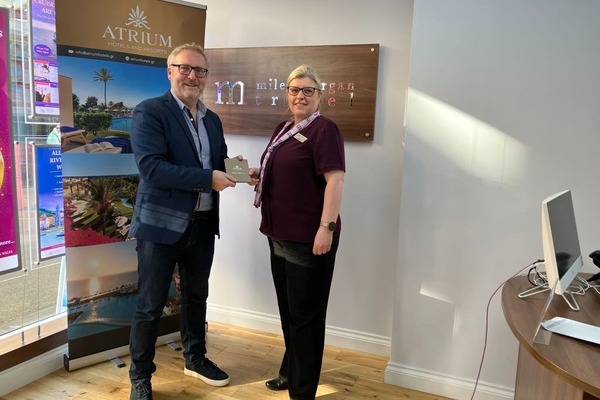Life on the edge – the conservation fight for survival in Kenya
As travellers increasingly look for positive impact when they travel, there are plenty of ways to help them do so, including a trip to Kenya with A&K to understand efforts to save a rhino species from extinction and see how a simple water system can help elevate a child’s life
I’m crouched behind a bush in the middle of Ol Pejeta Conservancy, no not for that… I’m waiting to see how long it will be before Otis finds me. This sizeable bloodhound was given my scent just minutes before, and now he’s bounding in a line straight towards me.
He’s one of a K9 unit at Ol Pejeta, a private wildlife conservancy in Laikipia Plateau, in the shadow of Mount Kenya. Among the rest of his crew are more bloodhounds and Dutch Malinois – they’re a friendly group, running around exuberantly as we spend time earlier in their enclosure learning about the work of the anti-poaching unit, one of the first private conservancy dog units in Kenya.
These dogs support a team of dedicated rangers and together, they do all they can to protect the 90,000-acre conservancy from poachers who would seek to strike the wildlife population, including awesome rhinos. Ol Pejeta had 20 black rhinos in 1993, and successful breeding combined with the work of its tough anti-poaching operations has allowed this number to flourish to over 165 today, the largest black rhino sanctuary in East and Central Africa. And there are two other rhino who get special attention though – ones thought to be the last two northern white rhinos on the planet.
This mother (Najin) and daughter (Fatu) live as good a life as possible in a 7,000-acre enclosure, treated like the royalty they are, albeit one under 24-7 armed protection for their own safety. They arrived here in 2009 from a zoo in the Czech Republic in the hopes more natural conditions would help chances of breeding. Their male ancestor Sudan – who came with them from the zoo – was the last known male on the planet, but his death in 2018 was a big blow.
And what had also became evident was one of the most tragic things: neither of these females is capable of carrying a calf themselves. Is nature telling us we’ve gone too far, and that we must just accept we have forced another species into the history books? Northern whites are now seen as “functionally extinct” – but there is some hope, as via assisted reproduction, there is a chance embryos could instead be put inside surrogate southern white rhinos.
Last September, three years after starting its ambitious programme to save the species from extinction, the BioRescue consortium successfully created additional embryos in a lab in Italy using harvested egg cells from Fatu, bringing the total to 22 matched with saved sperm from two late bulls and now being kept in liquid nitrogen.
Once the protocol to transfer the embryos to surrogate southern white rhino is optimized, these could be the foundation of a new northern white population, eventually destined to step back into their ecological role as keystone grazers in Central Africa.
Along with Najin, Fatu and all the black rhino, there are more than 30 southern white rhinos in the conservancy, gently grazing their way around the open plains. They roam in relative safety among other creatures such as 200 reticulated giraffe, with hearts that can weigh up to 10kg in order to pump the blood along that long neck to the brains of these elegant creatures. The conservancy is also home to endangered African wild dog, oryx, cheetah and bat-eared fox.
Giving back
Ol Peteja itself is a chameleon story – from a working cattle ranch in colonial Kenya in 2003 to a trailblazer of conservation innovation, this farm became a wildlife haven and is now an often hailed and copied model of African co-existence. It grows 900 acres of Rhodes grass for drought reserves, breeds livestock for sale, and another 4,000 acres is set aside for arable growing, to bring in the revenue to spend on conserving wildlife and fostering community development.
It also works with neighbours outside its fences to foster advanced agricultural techniques and to spread the word on how wildlife conservation translates to better education, healthcare and infrastructure for the next generation of wildlife guardians. It seems a well-oiled machine, one that was able to continue sending its agricultural wares to market during the pandemic and in turn, continue funding its conservation projects even when tourist numbers shrivelled.
And life in the conservancy does seem abundant. As soon as our little plane landed on the air strip from Nairobi, the safari begun in the vehicles despatched to collect us for the journey to our tented camp, Sanctuary Tambarare, launched last year (and recently joined in the area by an exclusive A&K mobile camp for up to 24 people).
Almost everywhere I looked, there was a dazzle of zebra trotting around the open plains (‘why do zebras have stripes’, I hear you ask – various theories: to give camouflage, confuse predators, even to deter flies who have been proven to avoid them), while a troop of around 50 baboons bounded across our track too.
On a more focused safari drive another day, we saw lion cubs dozing with their mum after a feed one morning under a tree, a beautiful sight. But disclaimer here: we’d managed to witness such an incredible scene with no other vehicles around us because mum was fitted with a radio collar as part of Ol Pejeta’s conservation programming.
This means you get to go out with a ranger looking for them for monitoring purposes and the data you collect goes straight to Ol Pejeta’s ecological monitoring unit, while helping find solutions to the challenges facing Laikipia’s lions. Being able to get up closer with wildlife through carefully orchestrated experiences such as this – and the rhino and anti-poaching sessions – not only gives visitors an insight into conservation and hopefully creates life-changed ambassadors, it of course brings revenue. Usual twice-daily drives are included in the cost of the stay at Tambarare, but these extra special Ol Pejeta experiences are chargeable, with lion tracking costing only around £50pp.
Moving moments
I may have been in Kenya to look at A&K’s new Sanctuary Retreats camp, but it was also to discover more about the work of A&K Philanthropy (AKP) and Sanctuary Retreats Philanthropy and I felt honoured to spend time at Oltafetta Primary School local to the Ol Pejeta Conservancy, about an hour’s drive from our camp).
In 2017, AKP and Sanctuary Retreats Philanthropy started the Safe Water for Schools Initiative to introduce sustainable, non-invasive means to acquire clean water for Maasai students. The program brings LifeStraw community filters in, portable high-volume water purifiers designed to deliver safe drinking water to schools in the Mara, so far delivering clean drinking water to more than 16,000 students.
LifeStraw’s hollow fibre purification technology converts contaminated water into safe drinking water by removing almost 100% of bacteria, viruses and protozoan parasites, helping prevent waterborne diseases common here, such as diarrhoea, typhoid, cholera and worms.
Sat on little plastic chairs in the shade of the school playground, we were as much the subject of curiosity as the big blue tank on a table in front of the kids: and it was mutual. I was fascinated to hear how LifeStraw can make such a difference – this was the 11th LifeStraw filter donated in this area (more than 40 have been given across Kenya) and the plan is to roll the programme further around the conservancy now that Sanctuary Tambarare is open.
It was emotional to see the kids understand how to get something we take for granted like a cup of fresh water; see them wash their hands in it; and laughingly learn little hygiene routines through songs taught by AKP’s local team. The school has been given something that will literally change lives. I don’t know which brought more tears, that, or the brave work of rangers to save the lives of those rhinos.
How to book it
Abercrombie & Kent offers a seven-night Kenya itinerary from £5,255pp, with flights and transfers, based on two sharing and including one night at Hemingways, Nairobi; three at Sanctuary Tambarare; and three at Sanctuary Olonana. This also includes the A&K exclusive experience of a session with the Ol Pejeta Anti-Poaching team and dog tracking; meeting the two northern white rhinos; and school visit to see the work of Abercrombie & Kent Philanthropy.
THE SUMMER ISSUE OF TTG LUXURY IS OUT NOW!
For more news, tips and destination features, see the latest issue of TTG Luxury. View the digital edition here



















